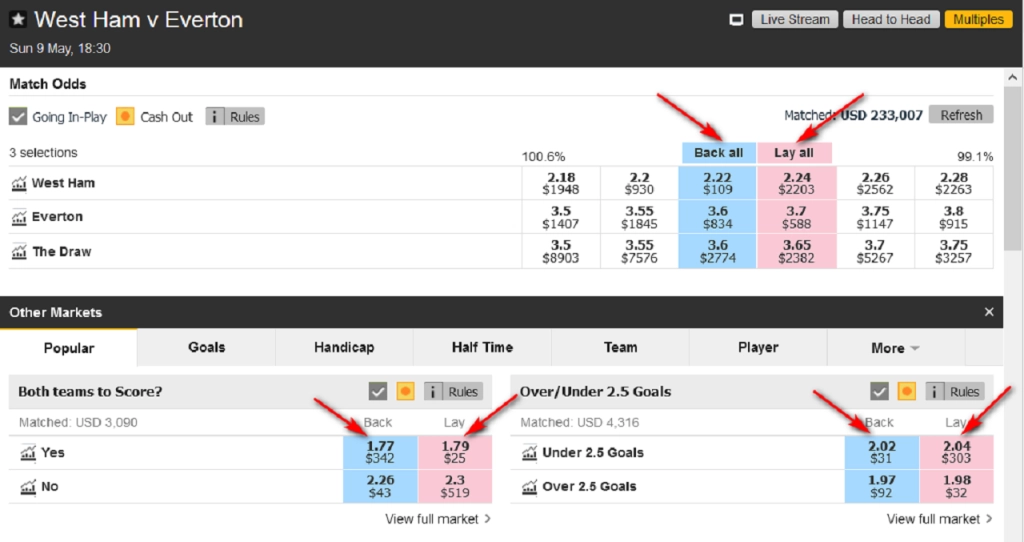
 Back and Lay Betting-Main
Back and Lay Betting-Main Understanding Back and Lay Betting
It's time to delve into the dynamic world of back and lay betting—a versatile strategy that offers the potential to significantly enhance your betting performance. By developing an understanding of this strategy, you can position yourself to gain maximum value from your bets and secure an edge over the competition.
Back and lay betting have emerged as popular strategies among informed bettors due to the potential for greater odds, enhanced value for money, and the prospect of generating profits through match betting. Let's dive deeper into the world of back and lay betting to get you primed for success.

Back and Lay Guide
Demystifying Betting Exchanges and Their Operations
Betting exchanges transformed the sports betting landscape by offering an alternative to traditional sportsbooks. The world's first betting exchange, Betfair, spearheaded this revolution, offering bettors the unique opportunity to assume the role of a bookmaker.
In essence, a betting exchange is a marketplace where bettors can place back and lay bets. You can choose to back a certain outcome (bet that it will occur) or lay the same outcome (bet that it will not occur). This system allows you to switch roles from a traditional bettor to a bookmaker.
While there are similarities between betting exchanges and sportsbooks, it's important to understand that they are fundamentally different. Traditional sportsbooks make profits by offering less efficient odds; the house always wins, even if all outcomes of an event are covered. In contrast, betting exchanges enable bettors to wager against each other rather than the operator, with the exchanges earning revenue through commissions on winning bets.
The Mechanics of Backing and Laying Bets
Sportsbooks have been around for centuries and have remained popular due to their straightforward operating model. Bettors wager on the outcome of a match or race. If the bettor wins, the sportsbook loses and vice versa. Sportsbooks ensure that they often come out on top by offering odds in their favor.
With betting exchanges, you can both back and lay bets, effectively allowing you to assume the role of the bookmaker. The exchange acts as a broker between the backer and the layer. To initiate a wager, a backer must back an outcome and a layer must lay the same outcome. Both parties must agree on the odds and stakes before the wager is accepted.
When you lay a bet, you're betting against a certain outcome. Essentially, you're wagering your money that a specific event won't occur. It's important to note that while you can lay a bet on anything, there's no guarantee that another player will be willing to back it.
A Practical Guide to Laying a Bet
The process of laying a bet is best explained with an example. Consider a Champions League game between Napoli and Red Bull Salzburg. Napoli are known for their strong performance at home, so you might want to back them not to lose.
Instead of going to a traditional sportsbook and placing a double-chance bet on Napoli/Draw, a more lucrative option might be to lay Red Bull Salzburg at a betting exchange.
To do this, you would click on the 'Lay' column corresponding to Red Bull Salzburg. The odds are those offered to bettors backing this team, and the number you see below the odds is the amount that has been staked on Red Bull Salzburg.
The potential amount you can win equals the amount the backers have staked. You can choose the amount you want to win, which can be higher or lower than what the backers have staked.

What is Lay and Back in Betting
Mitigating Risks
Due to the risks associated with laying bets, it's crucial to have an effective risk-management strategy in place. For instance, in the example above, you stand to lose a substantial amount if Red Bull Salzburg wins. This liability can be calculated as:
(Lay odds - 1) * Your stake.
So if you lay Red Bull Salzburg with a stake of $10 at odds of 5.0, your liability is:
(5.0 - 1) * $10 = $40.
This means that if Red Bull Salzburg wins, you lose $40. If they don't win, you win $10.
To manage risk, you can use the following strategies:
- Keep your liability manageable: It's advisable to lay bets with a liability that you can afford to lose. This reduces the risk of wiping out your bankroll on a single bet.
- Hedge your bets: Hedging involves placing bets on different outcomes to limit potential losses. This can involve backing an outcome at a sportsbook and then laying the same outcome on a betting exchange.
- Understand the market: The more you understand the dynamics of the sport and the teams involved, the better positioned you'll be to make informed betting decisions.
- Employ a matched betting strategy: Matched betting involves placing back and lay bets on the same outcome to lock in a profit. The principle is to use free bets and bonuses offered by sportsbooks to bet on all outcomes of an event, thereby ensuring a profit regardless of the result.
The Role of Arbitrage in Back and Lay Betting
Arbitrage is a financial term that refers to the practice of exploiting price differences in different markets to secure a risk-free profit. This principle can be applied to sports betting through the process of back and lay betting.
In the world of sports betting, an arbitrage opportunity arises when you can back an outcome at higher odds than you can lay it. This guarantees a profit regardless of the outcome.
Arbitrage betting, or 'arbing', involves using a betting exchange and a sportsbook. You back an outcome at a sportsbook at higher odds and then lay the same outcome on a betting exchange at lower odds. The disparity between the odds allows you to lock in a profit.
Arbing requires a lot of time and effort, and is not without its risks. Bookmakers can limit or close your accounts if they suspect you of arbing. But, when done correctly, it can provide a steady, albeit small, stream of profit.

Back and Lay in Cricket Betting
Conclusion
Back and lay betting strategies offer an innovative way of wagering on sports. By understanding the mechanisms behind these strategies and how to effectively mitigate risks, you can potentially secure a steady stream of profits from your wagers.
Remember, while back and lay betting offers the potential for greater profits, they also come with a greater risk. As with all forms of betting, these strategies should be used responsibly. Always bet within your means and remember to enjoy the process!
FAQ
What is back and lay betting?
Back and lay betting is a betting strategy that involves placing two opposing bets on the same event. A back bet predicts that an outcome will happen, while a lay bet predicts that the same outcome won't happen.
How can I mitigate the risks associated with lay betting?
There are several strategies to manage risk in lay betting, including keeping your liability manageable, hedging your bets, understanding the market, and employing a matched betting strategy.
What is arbitrage in the context of back and lay betting?
Arbitrage, or 'arbing', in back and lay betting is a strategy where you exploit the difference in odds offered by different bookmakers to secure a risk-free profit. This involves backing an outcome at a sportsbook at higher odds and then laying the same outcome on a betting exchange at lower odds.